Earned Value Management - EVM
Contents |
Abstract
Earned Value Management is a very powerful and popular project monitoring tool. Monitoring and controlling are key practices in project management, serving the purpose of informing project managers on the advancement of the project. Thus, data on the planning process and its advancement allows, through earned value management analysis to be investigated and results to be anticipated.
Earned Value Management is mainly used in highly complex environments like construction and infrastructure and allows for a combination of time and cost controlling [1], therefore guaranteeing a more holistic overview of the project advancement than other monitoring tools.
This article will firstly provide a description of the tool and its purpose including formulas and essential vocabulary. Then, it will provide a framework on how to apply this methodology. Lastly, it will look into its limitations, and explore the reasons why it is mainly used in very complex projects and environments [2]
Earned Value Management Overview
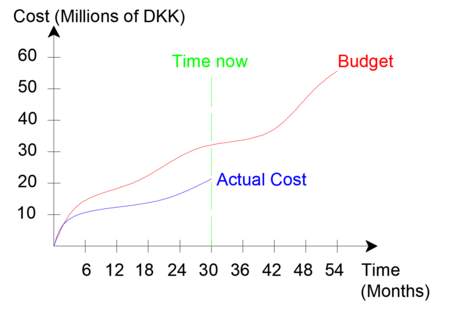
“How is your project going?” is a very frequently asked question to project managers and one it’s not easy to answer. As pointed out by Lukas, Joseph A. [3] one of the techniques that are frequently used in project management is comparing the planned expenditure curve with the actual one. [4] However, this approach can cause major errors and provide misleading information. As projects are complex processes that involve a large number of aspects and dimensions, controlling just one of these dimensions is too simplistic. For example, in the case shown in Figure 1, it is not clear if the work is being accomplished with less money than anticipated, or if the project is behind schedule. The scope of earned value management is to provide a bi-dimensional tool, that is able to plot both the time and cost dimension of the project, providing a more holistic monitoring method, such that one single graph contains a much larger amount of information on the project.
Terminology
As pointed out by the literature [3][2] it is important to clarify the terminology associated with Earned Value, as it is a source of confusion for many:
- Earned Value Analysis (EVA) is a quantitative method of assessing the progress of a project at any given point in time, predicting its completion date and final cost, and evaluating cost and schedule variances as the project progresses. Its objective is to assess whether the cost, schedule, and work done are progressing in accordance with the plan, comparing the expected amount of work done with what has actually been achieved. [5]
- Earned Value Management (EVM) is a project management methodology that uses an integrated schedule and budget approach and is based on a WBS to objectively evaluate project performance.
- Earned Value Management System (EVMS) is the method, processes, resources, and models that a company uses to implement Earned Value Management.
Earned Value Analysis formulas can be used on any project, but if an Earned Value Management methodology is not in place, it would be highly unlikely to produce accurate results. Moreover, in order to implement Earned Value Management, there must be an Earned Value Management System in place. The three concepts are therefore very closely linked to each other.
Earned Value Analysis : basic formulas and definitions
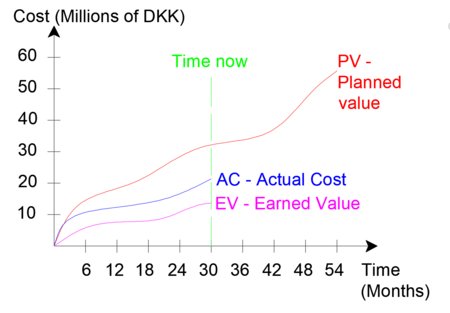
To carry out Earned Value Analysis, three key values need to be available: the planned value (PV), actual cost (AC), and earned value (EV). The first and second terms are the planned and actual expenditure cost, and should therefore be easy to obtain. The third term (earned value) is however more complicated to estimate as it measures the amount of value the actual completed activities have created. In detail:
- The Planned Value (PV) is the budget for the work planned to be done at a given point in time [6] . Planned Value is also referred to as Budgeted Cost of Work Scheduled (BCWS).
- Actual Cost (AC), is the cost incurred for the execution of project work at a given point in time, also known as an actual expenditure. It can also be seen as the actual costs (AC) incurred to convert the planned value into the earned value [2] Sometimes it is referred to as the Actual Cost of Work performed (ACWP).
- Earned Value (EV) is the amount of authorized work that was actually accomplished at a given point in time measured through the amount of management’s initial budget for the accomplished work. This is also regarded as the budgeted cost of work performed (BCWP). EV can be defined by multiplying the budget for a work package or activity by the percentage of advancement: EV = percent complete x budget. [6]
Once the key parameters are established, and a measuring tool for each of these is defined (as will be explained later), some more calculations can be carried out. [6]
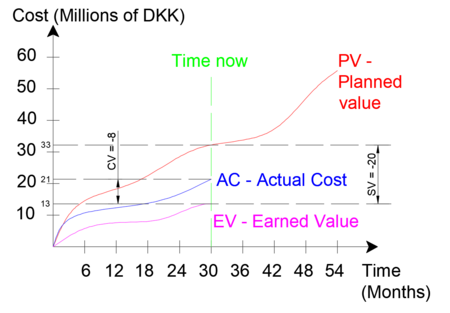
- Schedule Variance : SV = EV – PV.
- Schedule performance index : SPI = EV/PV. An SPI value of 1.12 means that 1.12 DKK worth of work was actually completed for each DKK of work that was planned to be done at this point in time. A SPI> 1 and SV> 0 suggest that more work was been completed at a certain date than what was scheduled. However, an SPI > 1 does not actually mean that the project is ahead of time
- Cost Variance : CV = EV – AC
- Cost performance Index : CPI = EV / AC. A CPI value of 0.97 signifies that 0.97 DKK is earned for each DKK spent. If the CPI<1 and CV<0 , the cost performance of the project is below what was planned.
Figure 3 shows an example of Planned Value, Actual Cost, and Earned Value. Note that it indicates a difference of +12 mln DKK when the scheduled spending curve is compared to the actual spent. It is likely that an uneducated reader would assume that the project team is doing the expected work and doing it for less money. However, by observing the graph through an Earned Value Analysis perspective, the reality is very different. The cost variance at 30 months is of -8 mln DKK and the schedule variance is of -20 mln DKK. At this point in time the project has earned 13 mln DKK instead of the scheduled 33 mln DKK. The work accomplished has also costed 21 mln DKK, when it was budgeted at 13 mln DKK. Therefore, the project is behind schedule and overspending.
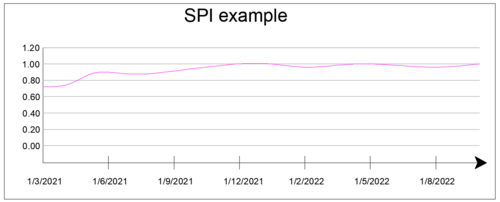
Predicting with earned value management
SPI: Schedule Efficiency Indicator
Figure 4 shows the SPI’s variation in function of time. SPI greater than 1.0 means that more work was done than expected, and an SPI less than 1.0 implies that less work was done than scheduled. A careful approach is essential when using SPI, as, without taking into account how the team is doing against the critical path, the project health cannot be evaluated[2]. It is common that, as the project is just starting up and activities are being initiated an SPI below 1.0 is measured for the first few reporting periods. However, if, after the first few reporting periods, the SPI does not progress towards 1.0, it is a sign of potential schedule issues and, thus, possibly indicates that it is necessary to take appropriate measures.
EVM isn't used to predict the end date or estimate the period to completion. Extensions to EVM, however, have been created to use EVM data for that purpose. Anbari, F. T. (2011) provides a detailed description of Earned Schedule (ES) which allows EVM metrics to be converted into time or duration metrics to improve project schedule assessment and forecasting [7].
Calculating project expenditures using CPI
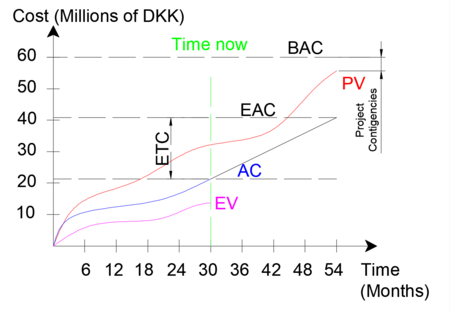
The Cost Performance Index is an ideal cost-efficiency metric for accomplished work. The primary use of CPI is to forecast the final cost of the project. As highlighted by the literature [8] a few definitions need to be specified prior to listing the typical formulas used:
- Estimate to Complete (ETC) is the estimated additional cost required for the project to be completed.
- Estimate at Completion (EAC) is an approximate total cost of the project at its completion.
- Budget at completion (BAC) is the complete authorized budget at completion of the project (including any project contingencies). Most projects have a cost contingency, which is an allowance for "known unknowns" including rework, predicting volatility, unexpected incidents, or issues. These are not included in the PV.
Most of the approaches for evaluating the EAC include a revision of the original cost estimate based on the performance of the project up to date.
The formulas that are most common are:
- EAC1 = AC + (BAC - EV). This calculation is often referred to as the “overrun to date” or “mathematical” formula. This formula implies that the schedule will be executed as planned for the remaining work (CPI = 1.0). If a project is not performing well, this formula tends to be too optimistic.
- EAC2 = BAC/CPI. This formula is sometimes called the 'cumulative CPI' and it means that the whole project can be carried out at the current value of cost efficiency (current CPI does not vary)
- EAC3 = AC + ((BAC - EV) / (CPI x SPI)) or BAC/(CPI x SPI). These ratios take into account the effect on the EAC on both cost and schedule and typically produce the most negative EAC for a project not performing well. [3]
The CPI parameter is empirically proven to stabilize at the 20 percent completion stage of a project (with over 700 DOD projects studied).[9] Also, as the project progresses towards the 100 percent completion stage, the CPI metric becomes increasingly more stable. Stability is defined to mean that the final CPI does not vary by more than 0.10.
To Complete Performance Index (TCPI)
The To Complete Performance Index (TCPI) allows the project manager to estimate the necessary performance level of the remaining work, expressed in CPI, in order to complete the project on budget. This measure can either be referred to the authorized budget (BAC) or to the current EAC. TCPI provides a "sanity check" for the project manager on whether the required CPI for the remainder of the project is realistically obtainable. Of the two calculations, looking at the CPI required to complete the project the one based on EAC is considered to be more accurate[6]. The two formulas for TCPI are:


Earned Value Management Application
Measuring PV, AC and EV
Progressing Techniques for Earned Value (EV)
In reality, it can be complicated to assess concrete advancement for Work Packages (WP), but it is essential in order to ensure a reliable and relevant Earned Value Analysis. Obviously, quantitative methods are much better for assessing project progress than qualitative (subjective) techniques. When calculating project success, it’s important to consider that it is an estimation. It is very common to spend too much time generating very precise values for Earned Value. But it is recommended to not spend too long estimating EV for small work package as it's much more efficient to focus on the work packages with a larger value. [3] As the nature of work packages in a project varies, no standard form of advancement reporting is appropriate. Below is a summary of the six most popular methods for monitoring project progress. [6]
Quantitative progressing techniques are:
- Completed units: activities involving repetitive production of easily calculated pieces of work, where approximately the same amount of effort is needed for each piece.
- Incremental milestones. Work Packages (WP) can conveniently be separated into a series of sequentially managed tasks. The scope is broken into separate, measurable tasks, and by completing each task, an 'incremental milestone' is considered to be reached. Progress is only achieved when a milestone is completed.
- Start-finish is used for low-value and/or limited-duration tasks without clearly defined intermediate milestones. Either none or some minimal progress is made when the task has begun, and 100 percent progress is obtained at the end of the activity.
Qualitative progressing techniques are:
- Level of effort (LOE) is used when it is very difficult to calculate what work has been done for the allocated budget. It can be assumed that LOE is equal to the real budget-divided costs [3]. For example, if the budget of the project manager on a project is 200 000 DKK, and the project has been paid 100 000 DKK, then progress is estimated at 50 percent.
- Individual judgment is mainly employed when the progress is not easily assessed with other tools. While it is a very subjective method, it can create a fair estimation of progress if numerous perspectives from experienced team members are taken into account.
Other techniques:
- Combination techniques are suitable for complex work over a long period of time and use two or three of the methods listed above. Installing a building foundation can be an example. The excavation phase can be measured in completed units (removed cubic meters of earth), while the formwork can be assessed in incremental milestones, and the concrete pouring with start-finish method.
If LOE or individual judgment are used as assessment methods for 10% or more of the overall budget, there is a strong risk of not obtaining a precise calculation of the progress of the project.
The use of qualitative approaches to report project progress often causes team bias to creep into the progress measured. Therefore, quantitative estimation methods are strongly encouraged.
Cost collection (AC)
If you cannot obtain specific actual costs for your project, earned value will not produce correct results. Companies with numerous expense structures in use find it incredibly difficult to collect and record costs. A downside of cost systems is that they report only costs for invoices issued and/or paid. In general, any work contracted and any goods purchased would have invoices that delay a month or more from the completion of the work, clearly leading to cost underestimation.
To get around this problem, it is recommended to use an “adjusted actual cost” column for reporting actual costs (AC) [6]. “Adjusted actual cost uses the actual cost from your cost system, plus your estimate for outstanding invoices for work accomplished, which are called accruals” [3]. The project plan should include the expense monitoring process. This includes the frequency of the reporting and how the adjusted actual' costs will be measured and documented.
Planned value calculation (PV)
To determine the Planned Value, it is recommended to follow the steps specified in the Methodology to apply Earned Value Management (section 3.2) as this estimation is closely related to the framework for the application of EVM described below.
Methodology to apply Eaned Value Management
EVM requires that all work is identified, budgeted, and scheduled to the extent practicable. Therefore, the use of the earned value methodology must be properly planned, otherwise, the results risk being incorrect and the effort to obtain relevant measures can be extremely high. This is caused by the large amount of information that is needed to carry out Earned Value Analysis, which needs to be efficiently collected. The key is to provide well-defined requirements and a good project plan, which includes the work breakdown structure (WBS) to thoroughly document the scope and the integrated schedule and cost estimate into the WBS [10]. Below is the recommended procedure to successfully implement Earned Value Management. This list is a summary of the 32 requirements detailed in the ANSI-EIA standard, illustrating the setting-up of an Earned Value Management System (EVMS) and including about 200 attributes for these 32 criteria.
- 1. WBS - Deconstructing the Statement of Work (SOW) of the project that determines the project scope into separate, observable components for the creation of the Work Breakdown Structure (WBS) listing the activities/tasks needed to carry out the project [10]. A WBS is a clear reflection of the project's work scope, describing the hierarchy and definition of the activities to be carried out and the connection with the deliverables of the project. The approved work scope is broken down by the WBS into suitable elements for planning, budgeting, scheduling, cost accounting [3]. An increasingly detailed description of the project work is defined by each descending level. The WBS needs to be expanded to the extent required for project execution and control. Each WBS activity should be identified through a unique code[11] .
- 2. Calculating the cost for the effort and resources referring to the WBS activities and tasks.
- 3. Calculating the duration for each WBS activity and task.
- 4 Schedule the tasks in a logical way such that subsequent elements and the top-level milestones are enabled by lower-level schedule elements. The logic should also be driven by the critical path. One of the tools most used for scheduling is Gantt Charts that help defining the logical and chronological dependency between activities. The schedule of the project should have tasks corresponding to each WBS activity[11]. Through developing a project schedule and cost estimate that relates to the WBS, the project plan is integrating cost and schedule information. At this point, the PV can be plotted.
- 5. Establish methods for assessing the achievement of work as well as the data collection dates identifying the moments when the EVA should be performed. [11]
- 6. Collect actual costs (AC) and actual durations in the execution period per each WBS activity. The collection needs to be done at each data collection date.
- 7. Estimate the competition ratio of each project activity at each data collection point, using what was decided at step 4. The Earned Value can then be calculated.
- 8. Calculate the key EVA indexes (SV, SPI, CV, CPV, etc..), and analyze the results.
- 9. If necessary, adjust the schedule or reallocate resources to improve the duration or cost of the project.
Softwares like Microsoft Project and Primavera, if used correctly, can be very helpful in implementing EVM as they allow for integrated schedule and cost programming and controlling. They also automatically calculate the Earned Value Analysis key values.
The recommended workflow to implement Earned Value Management in the correct way is described above, however, to create a complete and well-functioning Earned Value Management System other aspects need to be taken into account.
- Change management process
There may be some concerns around this topic, the most extreme being that the project team does not have a change management strategy in place. It is essential that a change management system discussed in the project plan. It must include the protocol for addressing adjustments in scope and variance, the forms for tracking and assessing proposals for change, the mechanism for examining and authorizing changes, and the process for ensuring that changes are implemented into the existing schedule so that the estimates of earned value remain useful [6]. Changes that exist but are not known may be the second potential problem area. This may concern members of the project team who wish to add additional scope to the project and do not consider the cost or time added by those changes. It is key for project managers to stay informed on potential "extras" added to the project scope. If a change is accepted, the budgets for the tasks affected will be changed to:
Current Work Package Budget = Original Budget + Approved Changes
- Quality check
Estimating and budgeting mistakes frequently occur. This can be caused by poor communication, quantity discrepancies, or the use of incorrect prices. It is essential to have quality management mechanism in place, which should involve reviewing the planning phase deliverables such as the schedule and the cost estimation by professional project staff.
- Management Support
Management support for the process and not allowing management interference to impact the data is required to make earned value work as managers may have different motives for trying to affect what is published. EunHong Kima,*, William G. Wells Jr.b, Michael R. Duffey [12] pointed out management support as one of the key points for effective implementation of Earned Value management, through carrying out an empirical analysis.
Agile Environment
As the methodology evaluates cost and schedule against a baseline, earned value management is focused on approved project plans with set and well-defined scope. In contrast to conventional waterfall-like approaches, agile project management emphasizes incremental delivery and planning on several levels, rather than meticulously planning the entire project flow from the start. As a consequence, the implementation of EVM may be more complicated than previously mentioned. A possible solution is to transfer standard key EVM values to their counterpart in Agile environment : Velocity, Estimated backlog, and Cost. Popović, F., Atanasijević, T. and Atanasijević, S. (2019) [8] provides a detailed description of how to employ EVM in Agile environments.
Limitations
A large number of problems related to the implementation of Earned value Management arise from the large amount of information that needs to be collected, and that the majority of this data comes from estimation procedures. However, other frequently mentioned concerns such as " too high cost " and " too much paperwork " are no longer considered relevant by the literature. Instead, individual issues (e.g., incorrect evaluation of work done, and lack of EVM understanding) and organizational-culture-related issues (e.g., a culture of mistrust and some pressures to disclose only good news) have been identified as major concerns[12] . Limitations also arise from the application environment of the methodology as it was originally conceived for large and complex projects (such as for the DoD), and it is still mainly used for these. Fleming QW, Koppelman JM.6 [6] analyzed the reasons why it is not used on all projects, these are the main findings:
- 1. The terminology used in the method has varied a lot in the years making the method seem more complicated than it is and somewhat unappealing.
- 2.Modern Earned value management was initially introduced by the American airforce in the 1960s. In order to preserve the concept, the airforce developed the C/SCSC (Cost/Schedule Control Systems Criteria), this was a project management system of 35 criteria that had to be met to use the tool. Therefore, the requirements were by far too strict for a typical project manager to satisfy. In those days this methodology was mainly used on governmental mandated projects. Later, through a joint effort of the DoD and the private sector, the requirements were reviewed and published in the ANSIA-EIA 748, which still lists 32 requirements, and is still too perspective for small projects. It was only in 1996 that PMI issued their PMBOK Guide [1]. In this book the requirements are fewer and easily understandable. Thus, nowadays the earned value methodology is applicable to any project and also compatible with ANSIA-EIA 748 (used on larger projects). Nevertheless, the history behind this methodology causes it to mainly be used for large and complex projects, such as the ones it was initially created for.
- 3 Optimism of project managers. Some project managers resist the use of Earned Value management as they are repelled by the forecasts thinking it could become a self-fulfilling prophecy, instead of taking advantage of the early warning signals the method can provide which can help project managers take actions at an early stage to keep the project in the planned track.
Another limitation highlighted by Lipke W, Zwikael O, Henderson K, Anbari F. [13] is that the 20 percent complete CPI stability is likely to be applicable only to large and long-term projects. It is therefore unclear whether small-project managers should expect accurate data from this cost performance index.
Annotated bibliography
Fleming QW, Koppelman JM. (2010) Earned Value Project Management. 4th edition. Project management institute. - This book provides project managers with tips about how to use EVM effectively. The framework for applying EVM to medium and smaller projects is a major focus, but the book is still applicable for larger projects. In this book, the authors explore both viewpoints on EVM, with a preference for easy, broad-based EVM for use on all projects.
Lukas JA.(2012) How to make earned value work on your project. - This paper provides both an overview of the basics of EVM while also suggesting the steps to take to successfully implement the tool. This paper is about more than just using earned value analysis; it's also about getting a full and integrated project plan in place, which is a prerequisite for using earned value management.
Popović, F., Atanasijević, T. and Atanasijević, S. (2019) ‘Earned Value Management in Agile Projects’. - This paper contains both the fundamentals of EVM and suggests a framework to apply the technique to Agile Environments. In fact, as agile project management focuses on optimizing return on investment through early and consistent delivery of value, it is important to measure and control the ROI. Implementing EVM in Agile with only three simple planning parameters is one possible solution.
Anbari, F. T. (2011) ‘Advances in earned schedule and earned value management’ - This paper provides the key metrics of both EVM and ES. As well as an example for the application of both tools which allows project managers to evaluate the project's schedule performance and most importantly forecast the duration of the project.
References
- ↑ 1.0 1.1 Project Management Institute, I. (2017) ‘PMBOK Guide (6th edition)’, pp. 231–270.
- ↑ 2.0 2.1 2.2 2.3 Fleming QW, Koppelman JM. Using earned value management. Cost Eng (Morgantown, West Virginia). 2002;44(9):32-36.
- ↑ 3.00 3.01 3.02 3.03 3.04 3.05 3.06 3.07 3.08 3.09 3.10 3.11 Lukas JA. How to make earned value work on your project. PMI® Glob Congr 2012—North Am Vancouver, Br Columbia, Canada. 2012;(5):1-9
- ↑ Booz, Allen and Hamilton (2008) ‘Earned Value Management Tutorial Module 1: Introduction to Earned Value Management.
- ↑ ‘Earned Value Analysis’ (2014) Handbook for Construction Planning and Scheduling, (202), pp. 158–170. doi: 10.1002/9781118838167.ch6.
- ↑ 6.0 6.1 6.2 6.3 6.4 6.5 6.6 6.7 Fleming QW, Koppelman JM. Earned Value Project Management. 4th edition. Project management institute; 2010.
- ↑ Anbari, F. T. (2011) ‘Advances in earned schedule and earned value management’, PMI® Global Congress 2011—North America, Dallas, TX. Newtown Square, (October), pp. 1–13. Available at: https://www.pmi.org/learning/library/advances-earned-schedule-value-management-6217.
- ↑ 8.0 8.1 Popović, F., Atanasijević, T. and Atanasijević, S. (2019) ‘Earned Value Management in Agile Projects’, 5th LIMEN Selected Papers (part of LIMEN conference collection), (November), pp. 17–24. doi: 10.31410/limen.s.p.2019.17.
- ↑ Fleming W. The Earned Value Body of Knowledge (EV-BOK). Published online 2002:19073.
- ↑ 10.0 10.1 Steps T, Value E. 10 Steps to Understanding Earned Value Management.
- ↑ 11.0 11.1 11.2 Chance W. Earned value management systems ( EVMS ) you too can do earned value management. Published online 2006:19073."
- ↑ 12.0 12.1 Kim EH, Wells WG, Duffey MR. A model for effective implementation of Earned Value Management methodology. Int J Proj Manag. 2003;21(5):375-382. doi:10.1016/S0263-7863(02)00049-2
- ↑ Lipke W, Zwikael O, Henderson K, Anbari F. Prediction of project outcome is that the application of statistical methods to earned value management and earned schedule performance indexes. Int J Proj Manag. 2009;27(4):400-407. doi:10.1016/j.ijproman.2008.02.009